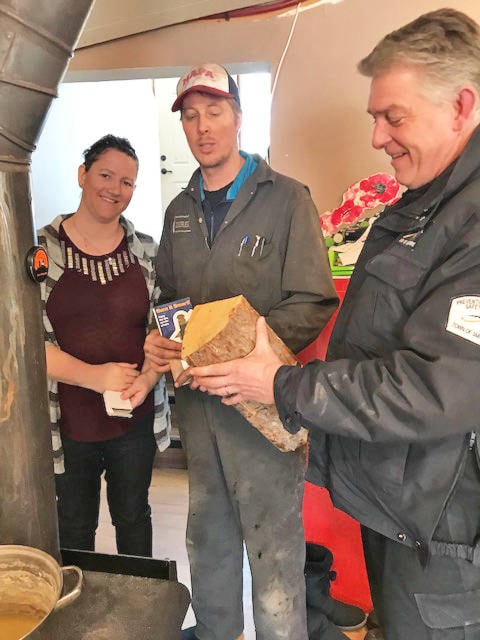As Community and Prevention Officer in the town of Smithers, part of Matt Davey’s job is to inspect woodstoves and investigate reports of improper burning during times of air quality advisory alerts. These alerts are issued when local air quality lowers to a level where it constitutes a public health risk in according to the Town’s bylaw.
“Wood Burning Appliance Smoke Control Bylaw #1520 was introduced in 2010 as a response to complaints and issues of poor air quality,” said Davey. “The Ministry of the Environment is also aware that we have a significantly high number of people within the municipality and the valley who burn wood as their primary source of heating.”
We live in a unique geographical location being in the valley. In wintertime we get a meteorological condition where we have inversions which keeps the air down in the valley. Quite often when those inversions happen, we begin to have quite a build-up of small particulate and smoke in the air, which then contributes to our poor air quality.
“I go door-to-door. We have a number of door-hangers that we put on people’s doors that talk about good burning process, as well as lay out the requirement for the bylaw. That is, you cannot burn a wood burning appliance during an advisory unless it is your sole source of heat.”
“Wood is a renewable resource and we are not in any way against burning wood, but I think it can be done in a way to reduce the negative side-effects. Studies that have been done about wood-smoke particulates have shown that it can be quite damaging. It’s actually smaller than the particulates that are in cigarette smoke and can embed itself in the lungs and can cause some difficulties for people with breathing difficulties, people with asthma, the elderly and small children.”
Davey is working with the Bulkley Valley Lakes District Air Management Society (BVLDAMS) in a “honey over vinegar” approach to the problem of improper burning practices.
“We prefer to approach people with interventions of education and incentives. The reason for that being that though our bylaw states that you should not be burning a non-certified appliance, enforcement is very difficult of that,” said Davey. “We will go and try to encourage people to make some differences, teach them about dry wood and good burning-practices, talk about the incentive program. For the most part, people want to be good neighbours. Writing a ticket is not going to be changing someone’s burning habits or behaviours.”
The incentive program Davey speaks of is the Highway 16 Wood Stove Exchange program, which offers cash-back rebates in exchange for old, non-EPA (Environmental Protection Agency) certified wood-burning appliances. The program was implemented by the B.C. Ministry of the Environment with the assistance of Environment Canada and BVLDAMS in 2007. Wood burning residents of the Bulkley Valley and Lakes District have a chance to switch over to more efficient, cleaner wood-burning appliances, paid for courtesy of the Regional District.
“If you have a stove that is over four years old there is a chance it does not meet current EPA standards,” said Davey. “Now that it is getting warm, now is the time to think about doing a swap-out, because you can’t do it in the middle of winter.”
The program involves some unique bonuses to the rebates based on varying criteria: Is the stove a secondary or primary heat source? Does the replacement stove use stacked wood, wood pellets, or gas? However, the conditions that need to be met are that a residence be within town limits, that proof is provided that the old appliance has been turned over to the town and decommissioned, and that the decommissioned appliance is replaced by an EPA-certified appliance. Davey and BVLDAMS recommend those interested apply to the program as soon as they can, as it operates on a first-come, first-served basis and funds are limited.
“For someone who has a woodstove as their sole source of heating in their home, within the municipality, if they were to approach the town about replacement, they could qualify for up to $1,900 as incentive from the town of Smithers and the regional district,” Davey said. “Now the rules for that is that it has to be your primary heat source, and to get the $1,900 you would have to move to an alternate source, which could be pellet, electric, or gas. If it’s your primary source, and you move to a high-efficiency wood-burning stove, you would get $1,750 if you were to replace your old one. If you live in the regional district, and you swap out a non-approved stove for another stove, you would receive $250. If you were swapping out, in the regional district, a non-compliant to something other than wood, you would receive $400. As you can see there is quite a significant financial incentive within town to do it.”
Davey gave an example of a typical pellet stove capable of heating a 1,200 square-foot house. At $1,300 to $1,500, the town is basically buying the stove.
“If you qualify for the $1,900, we’re paying for the stove and you’ve still got $400 to go towards installation.”
More information on the woodstove exchange program and better burning practices are available by contacting Susan Brooks and BVLDAMS at coordinator@cleanairplan.ca. Residents of northwestern B.C. who want to receive direct and instant air-quality advisory warnings to their email inboxes can sign up for the free service at aqadvisories.ca courtesy of BVLDAMS.
